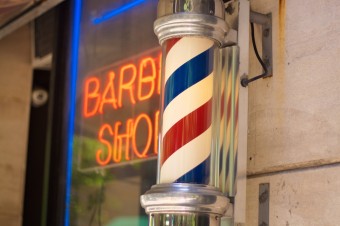
Red and white striped, sometimes with a bit of blue, a barber pole twisting next to a small storefront signifies a place where men can get a haircut, a shave and a bit of masculine bonhomie. But this was not always the case. Back in the day, the red and white we associate with good grooming used to represent blood, bandages, leeches and pain.
Because of papal prohibitions, barbers were also responsible for conducting surgeries.
Historically, the Roman Catholic Church believed that surgery violated the Holy Spirit’s temple (the human body). In line with this, several meetings of the church, including the Councils of Tours of 1163 and 1179 and the Fourth Lateran Council of 1215, decreed that priests and monks, who had a long history of medical and surgical scholarship, were forbidden from performing surgeries. Although priests continued to conduct research and serve as physicians for the wealthy, they relied on the barbers for surgical procedures and bloodlettings.
The procedure most commonly associated with barbers in the middle ages was bloodletting. Using a narrow blade, the barber would open a vein and allow the blood to pour down into a small brass bowl; by way of advertising, many barbers would display these bowls of blood in their shop windows so people would know they performed the service.
During the procedure, the patient would grip a white rod to encourage blood flow, and white strips of bandage would be used to clean the patient. Dirty bandages were washed and hung to dry on the grasping rod outside of the shop.
For those wounds too tender or hard to reach, rather than lancing and bloodletting, the barber would apply special leeches, known as Hirudo medicinals, which emitted a natural anesthetic and anti-coagulant while it sucked blood. These healthy, hungry leeches were typically kept on hand in a separate brass bowl.
The Pole
The famous pole is a study in semiotics. The white on the pole represents the bloodletting rod that was grasped by the patient during the procedure. The red stripes symbolize the bloodied bandages, often hung out to dry on the pole after they’d been cleaned as well as possible.
As for the rest, things get a little murkier. It’s is thought that the brass ball at the top may represent the bowl of leeches, while the brass at the bottom evokes the bowl that catches the blood. For those poles that have a blue stripe added, many believe this represents veins.
Of course, sometime in the middle ages, the profession of surgeon emerged, and afterward, surgeons and barbers competed for customers. To end the conflict, Parliament passed and King Henry VIII approved legislation that united both into the Barber-Surgeons’ Company in 1540.
Subsequent legislation was passed that further required barbers and surgeons to specialize and distinguish between the two groups by either having a red and white pole (surgeons) or one that was blue and white (barbers). So from this, perhaps the blue simply originally represented traditional grooming services.
Previous post: When and Why Women Started Shaving the Parts of the Body They Do
Read the whole thing at the always excellent Today I Found Out.
Read the whole thing at the always excellent Today I Found Out.
No comments:
Post a Comment